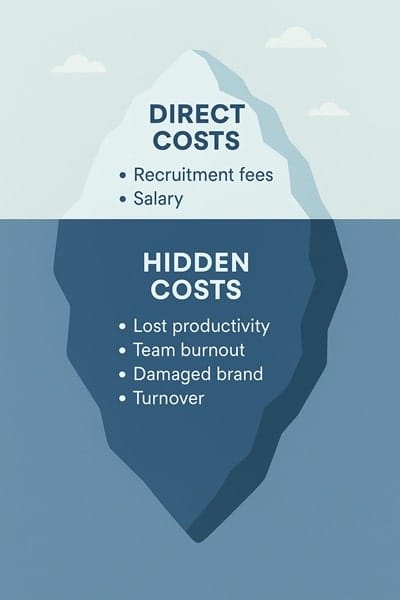 When companies make a bad hire—especially in a leadership position—the consequences reach far beyond a misaligned resume or a poor interview judgment. The ripple effects touch every corner of the organization, quietly draining productivity, damaging team morale, and racking up costs that can dwarf the original salary.
When companies make a bad hire—especially in a leadership position—the consequences reach far beyond a misaligned resume or a poor interview judgment. The ripple effects touch every corner of the organization, quietly draining productivity, damaging team morale, and racking up costs that can dwarf the original salary.
In this article, we’ll explore the real cost of a failed hire, how it impacts employee morale, and why business leaders need to treat hiring as a strategic, not tactical, decision.
The Tip of the Iceberg: Direct vs. Indirect Costs
Most leaders understand the direct recruitment costs of a failed hire: job board fees, agency fees, recruiter time, signing bonuses, and onboarding resources. But as with any iceberg, the most dangerous costs lie beneath the surface.
“The direct recruitment costs are just the tip of the iceberg; the indirect costs in lost productivity and strategic drift are where the real damage occurs.”
Here’s what lurks beneath:
- Wasted salary and benefits
- Manager time spent on oversight, corrections, and performance reviews
- Onboarding and training expenses that deliver no ROI
- Delays in achieving team or department goals
- Opportunity cost of lost business, innovation, or deals
According to Leadership IQ, up to 46% of new hires fail within 18 months. When this happens in key roles, studies suggest the total cost can reach 10–15 times the executive’s salary, especially when you factor in downstream impacts.
Team Morale: The Emotional Toll of a Toxic or Ineffective Hire
“A single bad hire can erode trust in leadership and poison the psychological safety of an entire team.”
Hiring the wrong person—especially someone who lacks self-awareness, collaboration, or integrity—can fracture team cohesion. When an employee doesn’t carry their weight or actively creates tension, the rest of the team suffers.
Here’s how morale gets crushed:
- High performers are forced to do “shadow work”—quietly correcting errors and covering gaps
- Resentment builds when a toxic or underperforming hire is not addressed quickly
- Trust in leadership drops when employees see poor decisions go uncorrected
- Psychological safety disappears, stifling innovation, feedback, and collaboration
“Productivity doesn’t just drop; your best employees burn out from the ‘shadow work’ of fixing mistakes and managing disruption.”
Turnover Contagion: When One Bad Hire Sparks a Talent Exodus
“Good people will not stay to work for or with bad leaders; a failed hire often triggers a wave of voluntary turnover among your A-players.”
When the wrong person is put in charge—or given a key role—top performers are often the first to leave. They see the dysfunction clearly, have options elsewhere, and are less likely to tolerate broken cultures.
This “domino effect of a bad hire on employee turnover” is rarely captured in financial models, but it can devastate your bench strength. Replacing high performers is expensive. Losing their institutional knowledge and customer relationships is even more damaging.
The Employer Brand Hit: Talent Talks
“A lack of a structured process creates a poor candidate experience, which can tarnish your employer brand among high-caliber professionals.”
Even candidates who weren’t hired will notice if your process felt rushed, vague, or unprofessional. And if your failed hire causes public problems—legal disputes, culture scandals, strategic reversals—your employer reputation can take a hit, making it harder to attract great talent next time.
Can This Be Prevented? Yes—With a Structured, Strategic Search Process
A robust, professional hiring process—especially for leadership or mission-critical roles—can dramatically reduce the risk of failure. That’s where retained executive search firms come in.
“A formal search provides objective vetting, confidential market access, and a structured process designed to mitigate these exact risks.”
By accessing the passive talent market, thoroughly assessing candidates beyond resumes, and benchmarking talent against industry bests—not just against each other—a structured process builds long-term success, not short-term relief.
Final Thoughts
“Studies suggest the total cost of a failed leadership hire can be as high as 15 times their annual salary when all impacts are considered.”
When you add up the cost of replacement, lost productivity, demoralized teams, and talent attrition, the case for making every critical hire count becomes clear.
The next time you’re tempted to rely on a shortcut—your gut, a referral, or a hurried process—ask yourself: What’s the real cost of getting it wrong?
The answer could be your culture, your strategy, and your best people.
From Aftermath to Action: Preventing the Next Bad Hire
The conclusion is clear: the true cost of a failed hire is a devastating combination of financial loss, wasted time, and cultural damage. Understanding these impacts makes it obvious that preventing a bad hire is one of the highest-return investments a leadership team can make.
The most effective form of prevention is adopting a rigorous, structured, and dedicated search process for your most critical roles. But how do you know when your hiring need has crossed the threshold from a standard recruitment task to a strategic imperative that requires a retained search partnership?
To help you diagnose your own situation and recognize the key indicators, we’ve created a definitive guide.
➡️ Read Our Guide: 5 Telltale Signs Your Company Is Ready for a Retained Search

